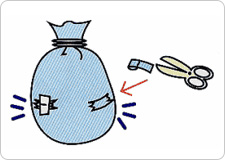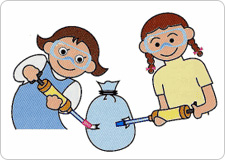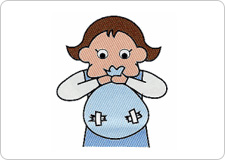Experiments with human respiration:
how oxygen is converted to carbon dioxide
how oxygen is converted to carbon dioxide
1Preparations
The process of human respiration (by which oxygen is inhaled and dioxide is exhaled) is examined.
Participants exhale into a plastic (polyethylene) bag several times, and the change in composition of the air inside the bag is observed/measured.
You will need
- One polyethylene bag (2 to 4 litre capacity)
- One rubber band
- Adhesive tape
- Scissors
- Gas detection equipment, comprising:
- Gas sampling pump
- Carbon dioxide detector tube 2EL
- Carbon dioxide detector tube 2EH
- Oxygen detector tube 31E
2The air is examined before respiration
- 2-1
- Attach two strips of adhesive tape to two opposite sides of the plastic bag as reinforcement. With the scissors make a small incision in each of the two reinforced places. Then cover each slit with another strip of tape and fold it for added strength so that air cannot leak.
- 2-2
- Exhale (blow) some air into the plastic bag, and seal the opening of the bag with the rubber band.

- 2-3
- Insert the carbon dioxide detector tube 2EL in one gas sampling pump, and oxygen detector tube 31E in another gas sampling pump. Peel off the upper strips of adhesive tape, and poke the tip of one detector tube through one incision and the other tube through the other incision. Then proceed to respectively measure the oxygen as well as the carbon dioxide concentrations and record the values.

- 2-4
- The two apertures are resealed with adhesive tape.
3After exhaling (blowing) once, the air is examined
- 3-1
- Remove the rubber band and after exhaling (blowing) into, the plastic bag 1-2 times, seal the opening of the bag with the rubber band.

- 3-2
- Insert the carbon dioxide detector tube 2EH in one gas sampling pump, and oxygen detector tube 31E in another gas sampling pump. Peel off the upper strips of adhesive tape, and poke the tip of one detector tube through one incision and the other tube through the other incision. Then proceed to respectively measure the oxygen as well as the carbon dioxide concentrations and record the values.

- 3-3
- Reseal the two apertures with the adhesive tape.
4After exhaling (blowing) five times, the air is examined
- 4-1
- Remove the rubber band and after exhaling (blowing) into the plastic bag 5-10 times, and seal the opening of the bag with the rubber band.

- 4-2
- Insert the carbon dioxide detector tube 2EH in one gas sampling pump, and oxygen detector tube 31E in another gas sampling pump. Peel off the upper strips of adhesive tape, and poke the tip of one detector tube through one incision and the other tube through the other incision. Then proceed to respectively measure the oxygen as well as the carbon dioxide concentrations and record the values.

5Interpreting the experiment results
Sample experimental data
| Start | after 1 inhalation / exhalation | after 5 inhalations / exhalations | |
|---|---|---|---|
| Oxygen | approx. 21% | approx. 18% | approx. 14% |
| Carbon dioxide | approx. 0.03% | approx. 3% | approx. 6% |
When breathing the amount of oxygen
is reduced and the amount of carbon dioxide increases!
-
Experiments with Detector Tubes
-
Let's think together

